ARTH`100: Unit 3 - The Ancient Worlds: The bronze age
1/52
There's no tags or description
Looks like no tags are added yet.
Name | Mastery | Learn | Test | Matching | Spaced |
|---|
No study sessions yet.
53 Terms
Empire
A major political unit where a central authority exercises control over a large territory or multiple territories, often through formal annexations or informal domination
Dynasty
A family or line of rulers, where successive sovereigns of a country are descended from a common ancestor.
Theocracy
A form of government in which officials are regarded as divinely guided, and often the legal system is based on religious law
Ziggurat
A pyramidal stepped temple tower, characteristic of major cities in Mesopotamia, serving both architectural and religious functions
Pyramid
A monumental structure with a rectangular base and four sloping triangular sides that meet at an apex. Common in ancient Egypt
Monarchy/Kingdoms
A political system where supreme authority rests in the hands of one ruler, usually achieved through heredity.
Temples
Architectural structures constructed for religious purposes, often showcasing a culture’s best design and craftsmanship
Trade
The action of buying and selling goods, initially through bartering, later involving precious metals and coins. The Sumerians were among the first to document trade using cuneiform.
Monumental Architecture
Large human-made structures used for public buildings or communal spaces, such as pyramids, tombs, temples, and observatories
Hierarchy of Scale
A technique in art where disproportionate scale is used to depict the relative importance of figures, often seen in Egyptian art
Votive Sculpture
Small sculptures or statuettes made to represent a person in worship, often placed in temples or altars as a symbol of devotion
Lapis Lazuli
A semiprecious blue stone that was highly valued in ancient civilizations and traded across regions, primarily sourced from Afghanistan.
Bronze
An alloy traditionally made of copper and tin, used for tools, weapons, and art in ancient civilizations
Brass
An alloy made of copper and zinc, dating back to Neolithic times
Silver
A precious, lustrous metal valued for its beauty and conductivity, often used in decorative art.
Gold
A dense, yellow precious metal, prized for its color, durability, and malleability, often found in nature in pure form
Faience
A tin-glazed earthenware used in Egypt for small sculptures or jewelry, easily shaped and mass-produced with colorful glaze.
Lost Wax Casting
A method of metal casting where a molten metal is poured into a mold created from a wax model, which is then melted away.
Mummification
The ancient Egyptian practice of embalming and preserving the body, often with preservatives for burial.
Papyrus
A writing material derived from the papyrus plant, commonly used in ancient Egypt
Sarcophagus
A stone coffin, often elaborately carved and decorated, that encases the body of the deceased
Pectoral
A large pendant or piece of jewelry worn over the chest, often ornamental or symbolic
Cartouche
A scroll-like ornamentation used around names or inscriptions, especially in ancient Egyptian art
Relief Sculpture
A complex art form where figures are carved on a surface, either slightly raised (low relief) or projecting far from the surface (high relief).
Painted Statuary
Statuary from the ancient world that was painted in bright colors, contrary to modern perceptions of white Greek sculpture.
Amulets
Objects believed to have protective or good fortune powers, often carried or kept in specific places.
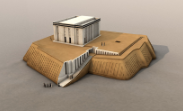
White Temple & Ziggurat
A pyramidal stepped temple tower
Made of mud bricks in Uruk
Served as a marker that travelling people would be able to see, signifying the city’s power and the power of the goddess
It was built on a ziggurat, and the entrance forced visitors to walk around before entering

Early Writing Tablet
Found in Uruk
Recorded allocation of beer and used a type of pictograph, which is an image-based wiritng system
The development of early writing, like cuneiform, was initally to account for surplus commodities such as barley, cattle, and oil, born out of economic necessity
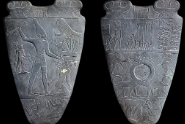
Palette of King Narmer
Made of slate and comes from Ancient Egypt
Provides context to religious beliefs and riches, and showcases visual concepts of the period
Utilizes iconography with consistent representations (conventions), organization in regular horizontal zones (registers), and hierarchical scale where larger figures are more important
Some interpret the battle scenes as a record of the initial unification of Egypt under one ruler
An example of proto-pictographic writing, using iconography to represent things

Shaft-hole axe head with Bird-headed demon, boar, and dragon
decorative, ceremonial, object
Made of silver gilded and beaten thin applied over the top
Before the Bronze Age, axe heads were made of stone
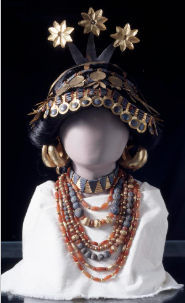
String of beads with gold leaf and ornamental gold discs with lapis centres
Found in the Royal cemetery
Lapis was very rare, as the Sumerians had very few minerals and it had to travel a significant distance from its source in northeast Afghanistan
The presence of such items indicates the wealth of the individuals buried
In one instance in the Great Death Pit, 68 women were found ornamented, likely killed to accompany the burial of a great personage, representing one of the earliest examples of mass ceremonial murder
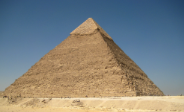
Pyramid of Khafre
One of the three main pyramids located at the massive mortuary site of Giza in Ancient Egypt
Devoted to three main kings and served as places of regeneration for the deceased ruler, acting as a container for the pharoah’s coffin
Texts from the time suggest a solar reference, with the pyramid perhaps intended as a version of the rays of the sun, acting as a ramp for the pharaoh to climb to the sky
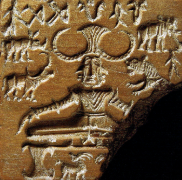
Seal
Small engraved objects, often used to mark ownership or authenticate documents in ancient civilizations
In Mesopotamia, seals made of materials like lapis developed alongside writing as a way to record someone’s identity, like their signiture
Cylinder seals, which could be rolled across clay to make an impression, were also used and were considered precious, often worn around the neck
In the Indus Valley Civilization, thousands of seals have been found, suggesting active trade and exchange
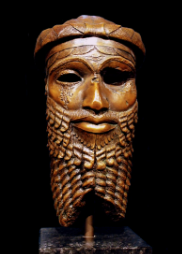
Head of Akkadian Ruler
Some kind of portrait, although the identity of the ruler is unknown (possibly Sargon)
The head was likely cast in a copper alloy
The eyes likely had inlaid contrasting material, and patterns are evident in the beard
The presence of a cloth turban supports the idea that this was an elite person, possibly king
Early example of a portrait and reflects qualities of fashion and style common at the time
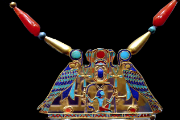
Pectoral and Necklace of Sithathoryunet with the name of Senworset II
Made of precious stones and were found among the jewelry in a tomb in Egypt
The hieroglyphic designs on the necklace invoke the god of the rising sun granting life and dominion to King Kahesper
The presence of falcons (symbols of the sun god) and cobras (protectors) along with the inscription promising millions of years, highlights the symbolism and the control of precious objects by those in power to demonstrate wealth and territorial control

Tutankhamun’s Tomb
Located in the Valley of the Kings in Ancient Egypt
Significant because it had not been robbed and contained a wealth of well-preserved artifacts, including a chariot, seats, and his famous Death Mask
The Death Mask is a gold inlaid mask depicting an idealized version of Tutankhamun
The Book of the Dead was also found in his tomb and was used for burials, believed to help continue the existence of those who died
His tomb provides great insight into the funerary practices and beliefs of the New Kingdom Egyptians, who were obsessed with life, death, and the afterlife
The bronze age saw
Development of large civilizations with theocratic political systems controlled by elites
An organized approach to agriculture and to water management made it easier to predict harvests and control trade with neighbors
A network of exchange across cultures led to increasing access to luxury goods and technologies
Cities with monumental architecture, internal plumbing, and walled fortifications were designed to provide comfort and protection to an increasingly urban population
Bronze-working
Required a furnace that reaches 1000 degrees Celsius
Involved mining valuable minerals from various far away locations to make the alloy
Led to stronger tools for harvesting
Was a specialized skill
Helped rulers to gain more territory through warfare
The earliest known writing was developed for
Communicating about trade
The bronze age period is marked by the development of
Writing
Cuneiform
First documented written language
Stylus
Sharpened reed used to make marks
Clay tablets
objects used to write upon
Seals
Carved pictographs that represented an individuals signature
Hieroglyphs
Unlike the English written language, which use letters to form a word, these are pictographs that can be either real-world objects or representations of spoken sounds (syllables)
The art and visual culture of the bronze age:
Was strongly shaped by religious practices
Elaborate grave sites have been found throughout this period replete with valuable objects, both ritualistic and practical, that were meant to accompany people into the afterlife
Funerary art continues to be important during this time and wealthy elites, including rulers who claimed to be gods, built elaborate tombs, pyramids, and monuments to commemorate themselves
Religious ideas are increasingly complex and involved the worship of gods who could be called upon to intercede on behalf of the dead
The Ancient Egyptians of the New Kingdom
Were obsessed with life, death, and the afterlife
Used monumental art and architecture to leave their mark on history
Gained and maintained their authority through the power of the gods: divine rule
Left an enormous record in the form of funerary art, which allows us to gain great insight into their culture today
The famous bust of Queen Nefertiti
Was actually a prototype
Was made in the studio of a well-known artist
Is a symbol for some of Europe’s colonial exploitation of cultural heritage from ither parts of the world
The militaristic Assyrians
Used their spoils of war to build incredibly beautiful palaces
The Lamassu
Were protectors of the cities of the Assyrians
Would have been incredibly intimidating to people wishing to enter through the gates
Were made of single, large pieces of stone
Show the importance of public art as a form of propaganda
Are duration monuments to the history of the ancient Assyrian empire
Understand how settlement and cultural development intersect
Many cities during the Bronze Age appeared near rivers, providing access to drinking water and fertile lands for farming.
Rivers also facilitated trade, which was essential for thriving settlements, especially for accessing luxury goods like gold, lapis lazuli, faience, and metals.
Organized approaches to agriculture and water management made it easier to predict harvests. This stability, along with trade networks, led to cultural exchange and increased access to luxury goods and technologies.
Settlements developed into larger civilizations with monumental architecture, such as walled fortifications, designed for protection and community
methods, components, and characteristics of bronze casting
Bronze is an alloy traditionally composed of copper and tin
Bronze-working was a specialized skill that required a furnace that reaches 1000 degrees Celsius
It involved mining valuable minerals from various far away locations to make the alloy.
The resulting bronze was harder than previous materials, leading to stronger tools for harvesting and weapons that helped rulers to gain more territory through warfare.
One method of bronze casting was the lost wax casting method, where a wax model is used to create a mold, the wax is melted away, and molten metal is poured into the hollow space
the relationship between "civilization" and social and political hierarchy in the Ancient world
The development of large civilizations during the Bronze Age often coincided with the emergence of social and political hierarchies
Many early civilizations had theocratic political systems controlled by elites, where government leaders were often seen as divinely guided
The control of resources, such as agricultural surplus managed by temple priests, reinforced this hierarchy
Hereditary rule and the establishment of dynasties further solidified power within certain families
In art, the hierarchy of scale was used to visually represent the relative importance of individuals, often emphasizing the power of rulers and elites
The construction of monumental architecture like palaces and temples served not only practical or religious purposes but also as displays of power and wealth controlled by the ruling classes